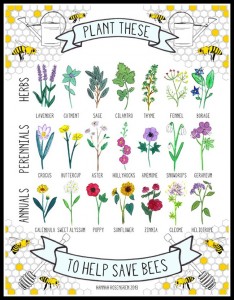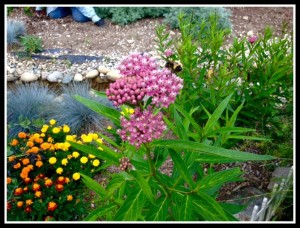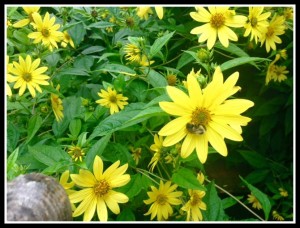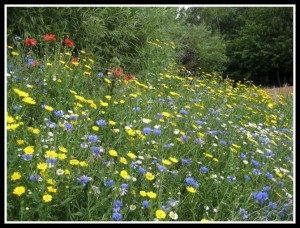Listening to an episode of The Environment Report on NPR recently, I was surprised to hear these words:
“Scientists are looking to see if other bees can fill in the gaps left by honey bees.”
This idea made me laugh, if somewhat ruefully. The speaker seemed to be implying that the bees were just hanging around, waiting for humans to discover them, rather than simply going about the business of feeding themselves, as all bees and other pollinators do.
The story went on to explain that nearly 20,000 species of bees already do a great deal of pollinating. Most do not live in social hives, however, like honey bees. Rather, many of them are solitary. They nest in the ground or in hollow reeds, or even in a modern “bee hotel.”
Habitat Needed
What these bees need, like so many other struggling creatures, is habitat. Humans have destroyed millions of acres of habitat through farming and building activities. Creatures who once lived in that destroyed habitat now have nowhere to live and often not enough to eat. And so, over time, their numbers dwindle or they go extinct.
According to Kenneth Eade in his book Bless the Bees, more than 85 percent of the world’s plant species — many of which compose important and nutritious parts of what we eat — require pollinators to exist. Given this fact, it’s clear that we really don’t want to do without pollinators, including bees. What is the solution? Can ordinary gardeners help in some way?
At least part of the solution is to help re-create habitat — and yes, according to many resources, gardeners can help do that.
Diversity, Diversity, Diversity!
The gist of the NPR piece explained a very solid ecological principle — that diversity is tremendously important. What we need to do is build habitat that supports many species, not just one. It may no longer be possible to put bees in boxes and transport them to crops. It may become necessary to provide for the bees where they would naturally live. What a concept!
To keep a healthy, diverse community of other bees on the farm, Carley Miller, one of the people featured in the NPR piece, says, “farmers will have to start adding bee habitat. That means planting things like wildflower patches next to fields so that these other bees have something to eat year round.”
An important consideration is bloom time. The bees need to start eating early in the spring and late into the fall. Careful plant choices will help keep the bee buffet open as long as possible!
How You Can Help
You may not be a farmer who needs to pollinate commercial crops, but perhaps you have a vegetable garden. Or perhaps you just want to help the bees. No matter what your reasons, your yard and garden can help not only the honey bees, but the up to 20,000 species of solitary and ground-nesting bees that are struggling, too.
Creating habitat for them may not solve all the problems the bees face, but surely it can help. Here are some ways to begin:
1. Plant flowers that bees like.

This chart by Hannah Rosengren shows several plants that will attract and feed bees. Herbs are lavender, catmint, sage, cilantro, thyme, fennel and borage. Perennials are crocus, buttercup, aster, hollyhocks, anemone, snowdrops, and geramium. Annuals are calendula, sweet alyssum, poppy, sunflower, zinnia, cleome, and heliotrope.
Kimberly Richardson of Demand Media, in an article titled “What to Use to Attract Bees to Pollinate a Vegetable Garden,” says “If you’re serious about attracting bees to your vegetable garden, plant flowers.” She continues, “… a lawn peppered with clover and dandelions sends [bees] into a pollinating frenzy … Not just any flower will do; wide, daisy-like flowers and native plants are much more attractive than exotic, tubular flowers … coneflowers (Echinacea spp.), sunflowers (Helianthus spp.), California asters (Aster chilensis) and seaside daisies (Erigeron glaucus) attract bees and are pleasing to the eye as well.”
2. Plant trees, shrubs and hedgerows for food and shelter. The website Buzz About Bees suggests that “trees, shrubs and hedgerows can provide nesting opportunities for bees, which may make their nests in abandoned rodent holes found at the base of a shrub, or in hollows, crevices or holes within the bark of a tree trunk.” The site also points out that these larger plants, with many blooms close together, are excellent for highly efficient foraging. Visit Buzz About Bees to peruse lists of plants to consider for early and late bloomers.
3. Don’t use pesticides or fungicides in your garden. If you want certain creatures in your yard, it’s best not to poison them! Evidence is mounting that pesticides and fungicides currently in use, while they may not be totally responsible for the declining health of bees, may make bees far less able to resist infestations and infections. In a recent study published in the journal PLOS ONE, scientists at the University of Maryland and the US Department of Agriculture identified “a witch’s brew of pesticides and fungicides contaminating pollen that bees collect to feed their hives.” You as a gardener cannot solve this huge problem, but you can stop using pesticides and fungicides yourself, and you can refuse to purchase plants pre-treated with them.
4. Leave bare ground here and there to make the nesting process easier. In the article 5 Ways to Help Our Disappearing Bees ,the Mother Earth Network notes that “natural bees make use of many kinds of shelter: abandoned animal burrows, dead trees and branches and underground nest tunnels.” It goes on to say this: “You can help wood-nesting bees by setting out a few inexpensive bee blocks. These are basically blocks of wood with holes of various sizes. Providing a mound or two of loose earth — particularly if they’re close to a water source — is like opening a rent-free apartment complex for burrowing bees.”
More Stories about Bees on this Blog
- A Review of A Sting in the Tale
- Six Cheap, Easy Things You Can Do to Help the Bees
- Three Top Bee-Pleasing Plants for Your Garden
Like this post? Sign up to receive an email each time a new post is available. We will never loan, sell or rent your email address — that’s a promise! Please use the buttons below to share with others.


